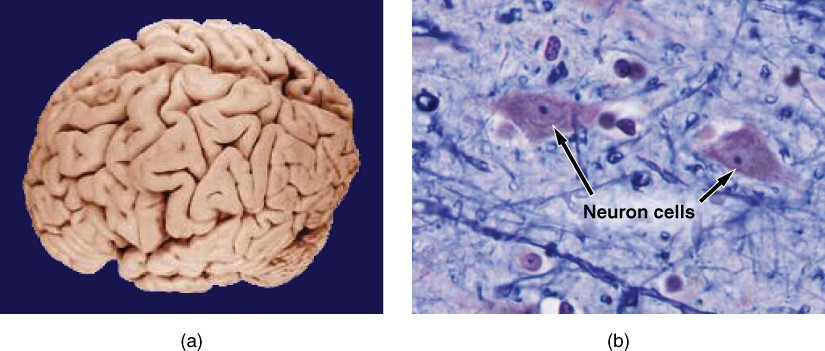1.1 Overview of Anatomy and Physiology
Anatomy is the scientific study of the body’s structures. Some of these structures are very small and can only be observed and analysed with the assistance of a microscope. Other larger structures can readily be seen, manipulated, measured, and weighed. The word “anatomy” comes from a Greek root that means “to cut apart.”
Like most scientific disciplines, anatomy has areas of specialisation. Gross anatomy is the study of the larger structures of the body, those visible without the aid of magnification (Figure 1.1a). Macro- means “large,” thus, gross anatomy is also referred to as macroscopic anatomy. In contrast, micro- means “small,” and microscopic anatomy is the study of structures that can be observed only with the use of a microscope or other magnification devices (Figure 1.1.1b). Microscopic anatomy includes cytology, the study of cells and histology, the study of tissues. As the technology of microscopes has advanced, anatomists have been able to observe smaller and smaller structures of the body, from slices of large structures like the heart, to the three-dimensional structures of large molecules in the body.

Anatomists take two general approaches to the study of the body’s structures: regional and systemic. Regional anatomy is the study of the interrelationships of all the structures in a specific body region, such as the abdomen. Studying regional anatomy helps us appreciate the interrelationships of body structures, such as how muscles, nerves, blood vessels, and other structures work together to serve a particular body region. In contrast, systemic anatomy is the study of the structures that make up a discrete body system—that is, a group of structures that work together to perform a unique body function, for example, a systemic anatomical study of the muscular system would consider all the skeletal muscles of the body.
Whereas anatomy is about structure, physiology is about function and is the scientific study of the chemistry and physics of the structures of the body and the ways in which they work together to support the functions of life. Much of the study of physiology centres on the body’s tendency toward homeostasis.
Homeostasis is the state of steady internal conditions maintained by living things. The study of physiology certainly includes observation, both with the naked eye and with microscopes, as well as manipulations and measurements. However, current advances in physiology usually depend on carefully designed laboratory experiments that reveal the functions of the many structures and chemical compounds in the body.
Like anatomists, physiologists typically specialise in a particular branch of physiology, for example, neurophysiology is the study of the brain, spinal cord, and nerves and how they work together to perform functions as complex and diverse as vision, movement, and thinking. Physiologists may work from the organ level (exploring, for example, what different parts of the brain do) to the molecular level (such as exploring how an electrochemical signal travels along nerves).
Form is closely related to function in all living things.
For example
At the macroscopic level, a cat’s claws can extend to grip surfaces or catch prey, and retract to avoid wear and injury during walking.
At the tissue level, specialized tendons and muscles in the paw control the extension and retraction of the claws with precision and speed.
At the cellular level, muscle cells contract in response to nerve signals, allowing the claw to move.
At the molecular level, this contraction depends on the interaction of actin and myosin proteins, powered by ATP.
At the atomic level, the three-dimensional structure of these proteins and the movement of calcium ions are essential for proper function.
Your study of anatomy and physiology will make more sense if you continually relate the form of the structures you are studying to their function.

